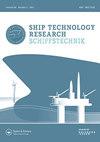Hydrodynamic optimisation of a multi-purpose wind offshore supply vessel
IF 0.9
Q3 ENGINEERING, MARINE
引用次数: 7
Abstract
ABSTRACT The aim of this study was to reduce the total resistance of a multi-purpose wind offshore supply vessel by optimising its hull. Resistance was computed using a potential flow boundary element method and a Reynolds-averaged Navier–Stokes equations solver. Optimised hull forms were obtained for the ship advancing at different ship speeds under calm water conditions, employing the two multi-objective optimisation algorithms, Non-dominated Sorting Genetic Algorithm II (NSGA-II) and Multi-Objective Simulated Annealing (MOSA). Using NSGA-II yielded slightly larger reductions of total resistances than MOSA. The greatest reductions were achieved at ship speeds between 11 and 14knots. At these speeds, a thinner and longer bulbous bow reduced resistance. At speeds greater than 15knots, a bloated bulbous bow was more helpful to reduce resistance.多用途海上风电供应船的流体动力学优化
本研究的目的是通过优化船体来降低多用途海上风力供应船的总阻力。采用位流边界元法和reynolds -average Navier-Stokes方程求解器计算阻力。采用非支配排序遗传算法II (NSGA-II)和多目标模拟退火算法(MOSA)两种多目标优化算法,对静水条件下不同航速推进的舰船进行了优化。使用NSGA-II的总电阻降幅略大于MOSA。最大的减少是在航速在11到14节之间。在这样的速度下,更薄更长的球茎船首可以减少阻力。在航速超过15节时,膨胀的球茎船首更有助于减少阻力。
本文章由计算机程序翻译,如有差异,请以英文原文为准。
求助全文
约1分钟内获得全文
求助全文

 求助内容:
求助内容: 应助结果提醒方式:
应助结果提醒方式:


